Criminal Law Assignment: Analysis of the Snow White Criminal Case
VerifiedAdded on 2023/06/07
|5
|1129
|226
Case Study
AI Summary
This case study analyzes a criminal law scenario involving characters from Snow White, focusing on charges of attempted robbery, attempted murder, and larceny. The analysis examines the actions of Snow White, Happy, and the Evil Queen, evaluating the elements of each crime and potential defenses. Key legal concepts discussed include self-defense, accomplice liability, and the impact of intoxication on criminal intent. The document explores the application of these legal principles to the specific facts of the case, considering the potential charges against each character and the likely outcomes based on juvenile regulations for Happy. The analysis also references relevant legal precedents and definitions to support its conclusions, providing a comprehensive overview of the legal issues presented in the scenario.
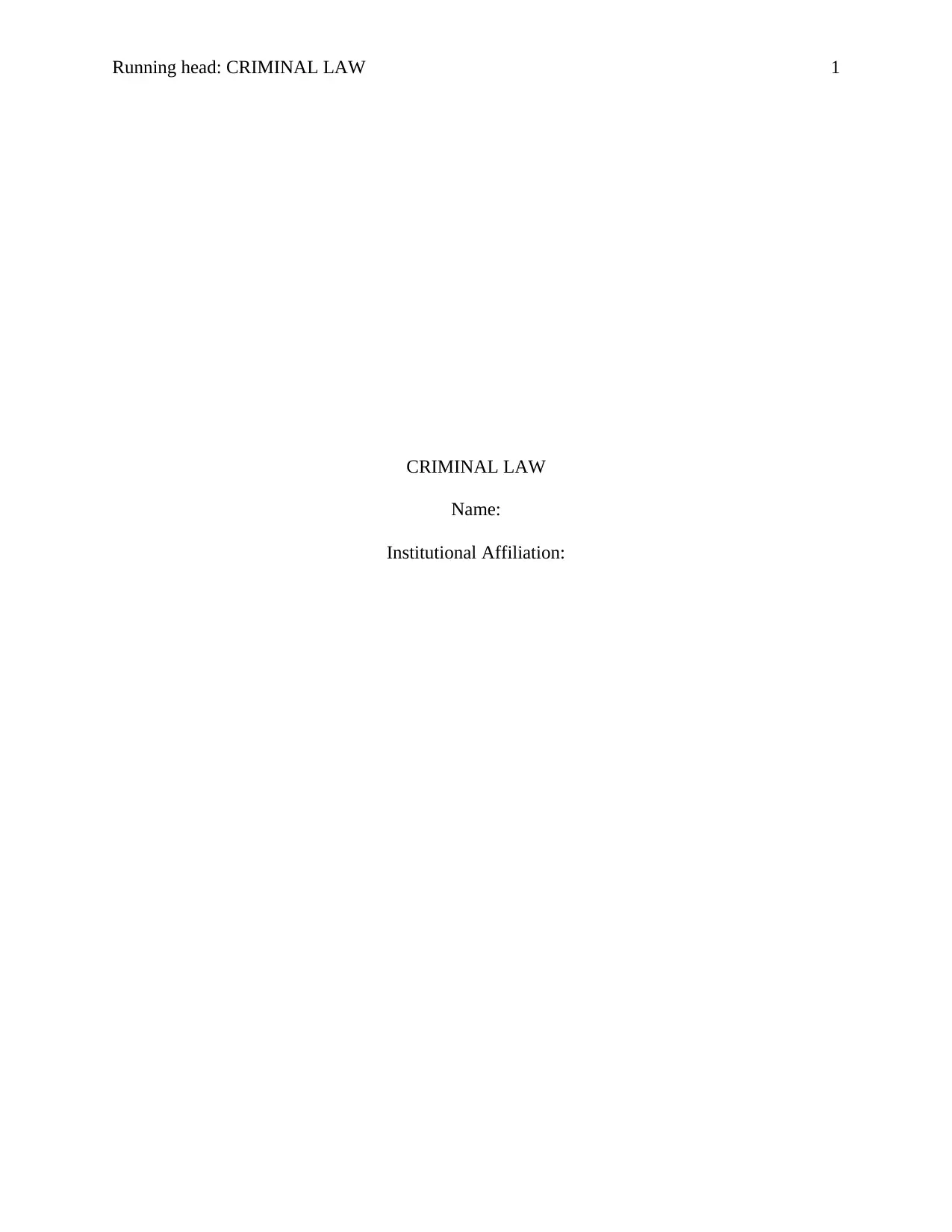
Running head: CRIMINAL LAW 1
CRIMINAL LAW
Name:
Institutional Affiliation:
CRIMINAL LAW
Name:
Institutional Affiliation:
Paraphrase This Document
Need a fresh take? Get an instant paraphrase of this document with our AI Paraphraser
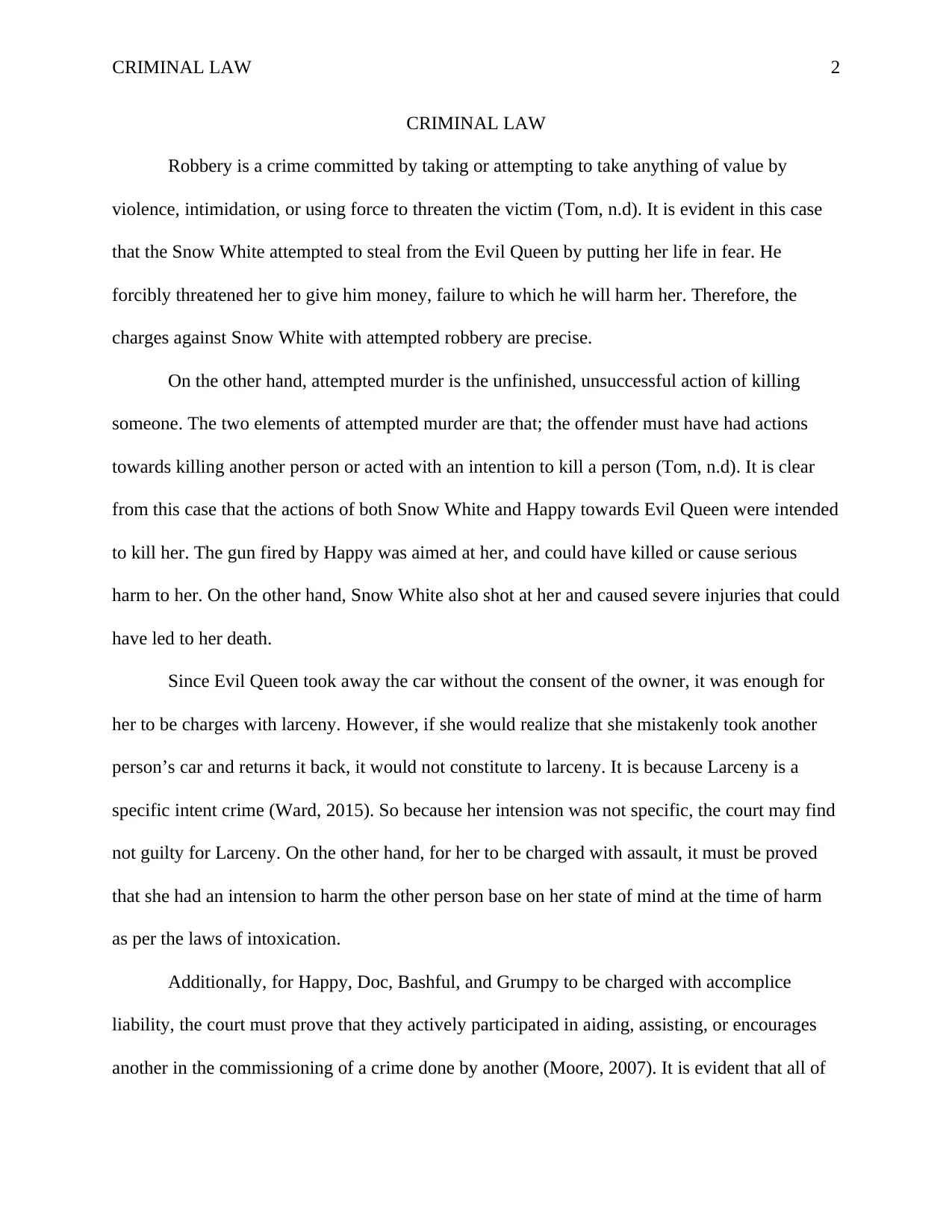
CRIMINAL LAW 2
CRIMINAL LAW
Robbery is a crime committed by taking or attempting to take anything of value by
violence, intimidation, or using force to threaten the victim (Tom, n.d). It is evident in this case
that the Snow White attempted to steal from the Evil Queen by putting her life in fear. He
forcibly threatened her to give him money, failure to which he will harm her. Therefore, the
charges against Snow White with attempted robbery are precise.
On the other hand, attempted murder is the unfinished, unsuccessful action of killing
someone. The two elements of attempted murder are that; the offender must have had actions
towards killing another person or acted with an intention to kill a person (Tom, n.d). It is clear
from this case that the actions of both Snow White and Happy towards Evil Queen were intended
to kill her. The gun fired by Happy was aimed at her, and could have killed or cause serious
harm to her. On the other hand, Snow White also shot at her and caused severe injuries that could
have led to her death.
Since Evil Queen took away the car without the consent of the owner, it was enough for
her to be charges with larceny. However, if she would realize that she mistakenly took another
person’s car and returns it back, it would not constitute to larceny. It is because Larceny is a
specific intent crime (Ward, 2015). So because her intension was not specific, the court may find
not guilty for Larceny. On the other hand, for her to be charged with assault, it must be proved
that she had an intension to harm the other person base on her state of mind at the time of harm
as per the laws of intoxication.
Additionally, for Happy, Doc, Bashful, and Grumpy to be charged with accomplice
liability, the court must prove that they actively participated in aiding, assisting, or encourages
another in the commissioning of a crime done by another (Moore, 2007). It is evident that all of
CRIMINAL LAW
Robbery is a crime committed by taking or attempting to take anything of value by
violence, intimidation, or using force to threaten the victim (Tom, n.d). It is evident in this case
that the Snow White attempted to steal from the Evil Queen by putting her life in fear. He
forcibly threatened her to give him money, failure to which he will harm her. Therefore, the
charges against Snow White with attempted robbery are precise.
On the other hand, attempted murder is the unfinished, unsuccessful action of killing
someone. The two elements of attempted murder are that; the offender must have had actions
towards killing another person or acted with an intention to kill a person (Tom, n.d). It is clear
from this case that the actions of both Snow White and Happy towards Evil Queen were intended
to kill her. The gun fired by Happy was aimed at her, and could have killed or cause serious
harm to her. On the other hand, Snow White also shot at her and caused severe injuries that could
have led to her death.
Since Evil Queen took away the car without the consent of the owner, it was enough for
her to be charges with larceny. However, if she would realize that she mistakenly took another
person’s car and returns it back, it would not constitute to larceny. It is because Larceny is a
specific intent crime (Ward, 2015). So because her intension was not specific, the court may find
not guilty for Larceny. On the other hand, for her to be charged with assault, it must be proved
that she had an intension to harm the other person base on her state of mind at the time of harm
as per the laws of intoxication.
Additionally, for Happy, Doc, Bashful, and Grumpy to be charged with accomplice
liability, the court must prove that they actively participated in aiding, assisting, or encourages
another in the commissioning of a crime done by another (Moore, 2007). It is evident that all of
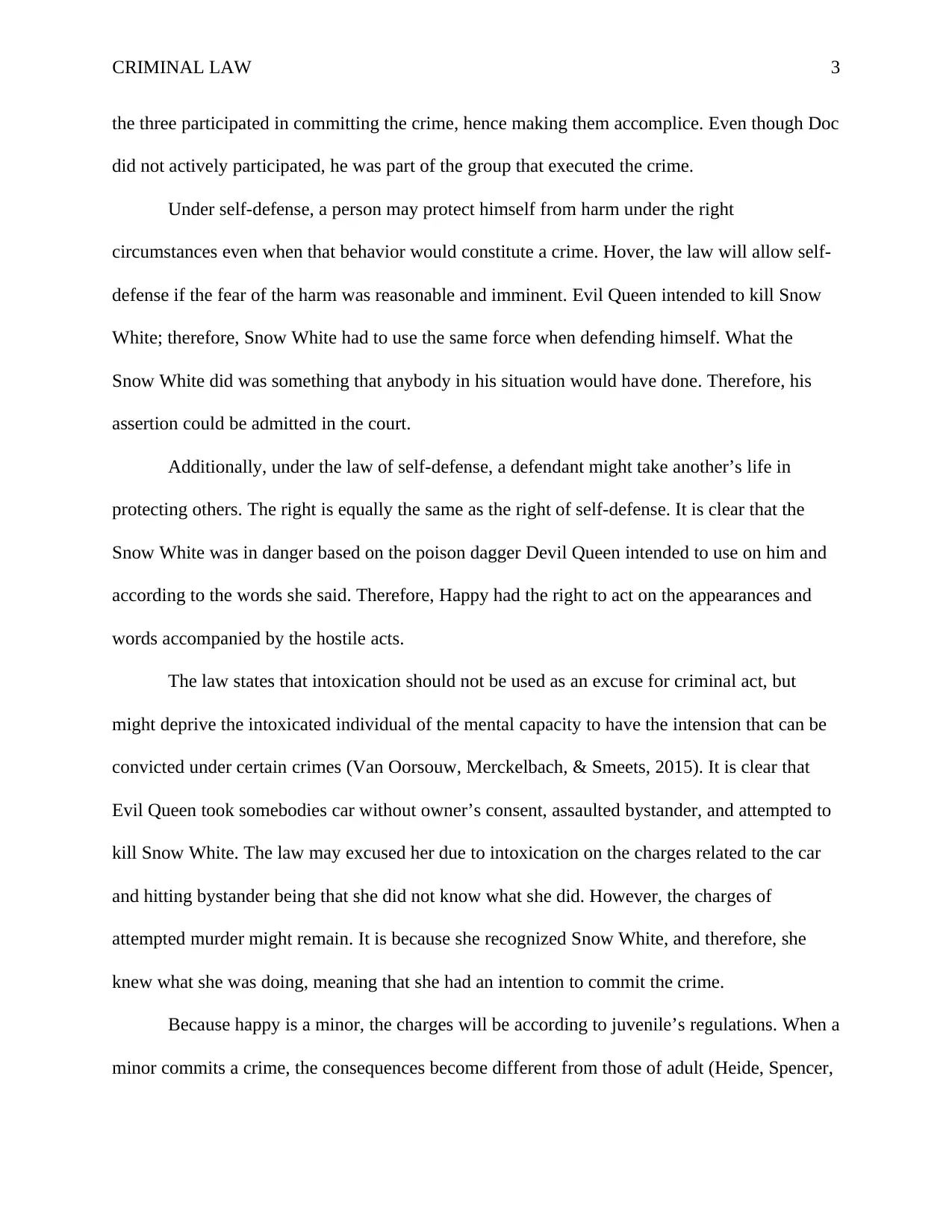
CRIMINAL LAW 3
the three participated in committing the crime, hence making them accomplice. Even though Doc
did not actively participated, he was part of the group that executed the crime.
Under self-defense, a person may protect himself from harm under the right
circumstances even when that behavior would constitute a crime. Hover, the law will allow self-
defense if the fear of the harm was reasonable and imminent. Evil Queen intended to kill Snow
White; therefore, Snow White had to use the same force when defending himself. What the
Snow White did was something that anybody in his situation would have done. Therefore, his
assertion could be admitted in the court.
Additionally, under the law of self-defense, a defendant might take another’s life in
protecting others. The right is equally the same as the right of self-defense. It is clear that the
Snow White was in danger based on the poison dagger Devil Queen intended to use on him and
according to the words she said. Therefore, Happy had the right to act on the appearances and
words accompanied by the hostile acts.
The law states that intoxication should not be used as an excuse for criminal act, but
might deprive the intoxicated individual of the mental capacity to have the intension that can be
convicted under certain crimes (Van Oorsouw, Merckelbach, & Smeets, 2015). It is clear that
Evil Queen took somebodies car without owner’s consent, assaulted bystander, and attempted to
kill Snow White. The law may excused her due to intoxication on the charges related to the car
and hitting bystander being that she did not know what she did. However, the charges of
attempted murder might remain. It is because she recognized Snow White, and therefore, she
knew what she was doing, meaning that she had an intention to commit the crime.
Because happy is a minor, the charges will be according to juvenile’s regulations. When a
minor commits a crime, the consequences become different from those of adult (Heide, Spencer,
the three participated in committing the crime, hence making them accomplice. Even though Doc
did not actively participated, he was part of the group that executed the crime.
Under self-defense, a person may protect himself from harm under the right
circumstances even when that behavior would constitute a crime. Hover, the law will allow self-
defense if the fear of the harm was reasonable and imminent. Evil Queen intended to kill Snow
White; therefore, Snow White had to use the same force when defending himself. What the
Snow White did was something that anybody in his situation would have done. Therefore, his
assertion could be admitted in the court.
Additionally, under the law of self-defense, a defendant might take another’s life in
protecting others. The right is equally the same as the right of self-defense. It is clear that the
Snow White was in danger based on the poison dagger Devil Queen intended to use on him and
according to the words she said. Therefore, Happy had the right to act on the appearances and
words accompanied by the hostile acts.
The law states that intoxication should not be used as an excuse for criminal act, but
might deprive the intoxicated individual of the mental capacity to have the intension that can be
convicted under certain crimes (Van Oorsouw, Merckelbach, & Smeets, 2015). It is clear that
Evil Queen took somebodies car without owner’s consent, assaulted bystander, and attempted to
kill Snow White. The law may excused her due to intoxication on the charges related to the car
and hitting bystander being that she did not know what she did. However, the charges of
attempted murder might remain. It is because she recognized Snow White, and therefore, she
knew what she was doing, meaning that she had an intention to commit the crime.
Because happy is a minor, the charges will be according to juvenile’s regulations. When a
minor commits a crime, the consequences become different from those of adult (Heide, Spencer,
⊘ This is a preview!⊘
Do you want full access?
Subscribe today to unlock all pages.

Trusted by 1+ million students worldwide
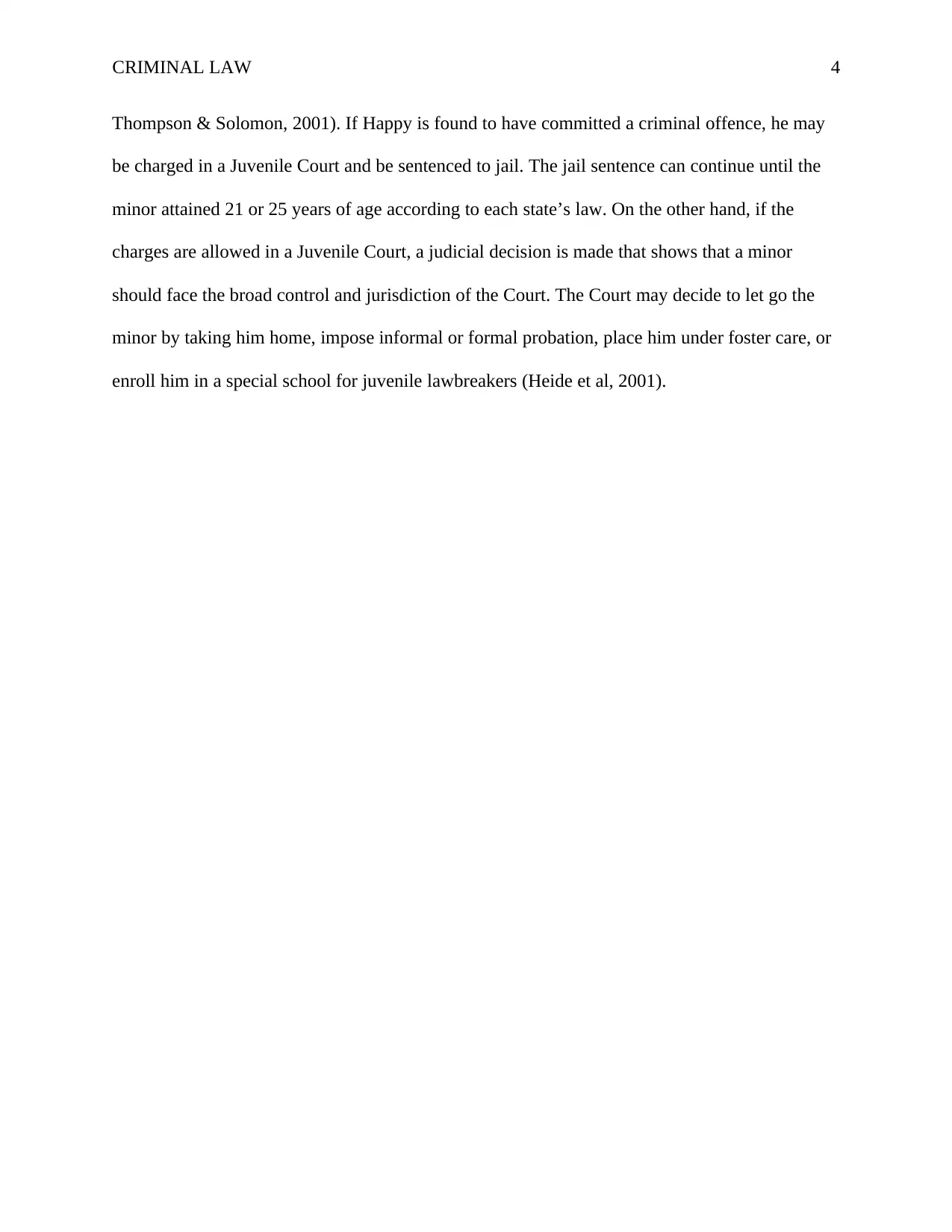
CRIMINAL LAW 4
Thompson & Solomon, 2001). If Happy is found to have committed a criminal offence, he may
be charged in a Juvenile Court and be sentenced to jail. The jail sentence can continue until the
minor attained 21 or 25 years of age according to each state’s law. On the other hand, if the
charges are allowed in a Juvenile Court, a judicial decision is made that shows that a minor
should face the broad control and jurisdiction of the Court. The Court may decide to let go the
minor by taking him home, impose informal or formal probation, place him under foster care, or
enroll him in a special school for juvenile lawbreakers (Heide et al, 2001).
Thompson & Solomon, 2001). If Happy is found to have committed a criminal offence, he may
be charged in a Juvenile Court and be sentenced to jail. The jail sentence can continue until the
minor attained 21 or 25 years of age according to each state’s law. On the other hand, if the
charges are allowed in a Juvenile Court, a judicial decision is made that shows that a minor
should face the broad control and jurisdiction of the Court. The Court may decide to let go the
minor by taking him home, impose informal or formal probation, place him under foster care, or
enroll him in a special school for juvenile lawbreakers (Heide et al, 2001).
Paraphrase This Document
Need a fresh take? Get an instant paraphrase of this document with our AI Paraphraser
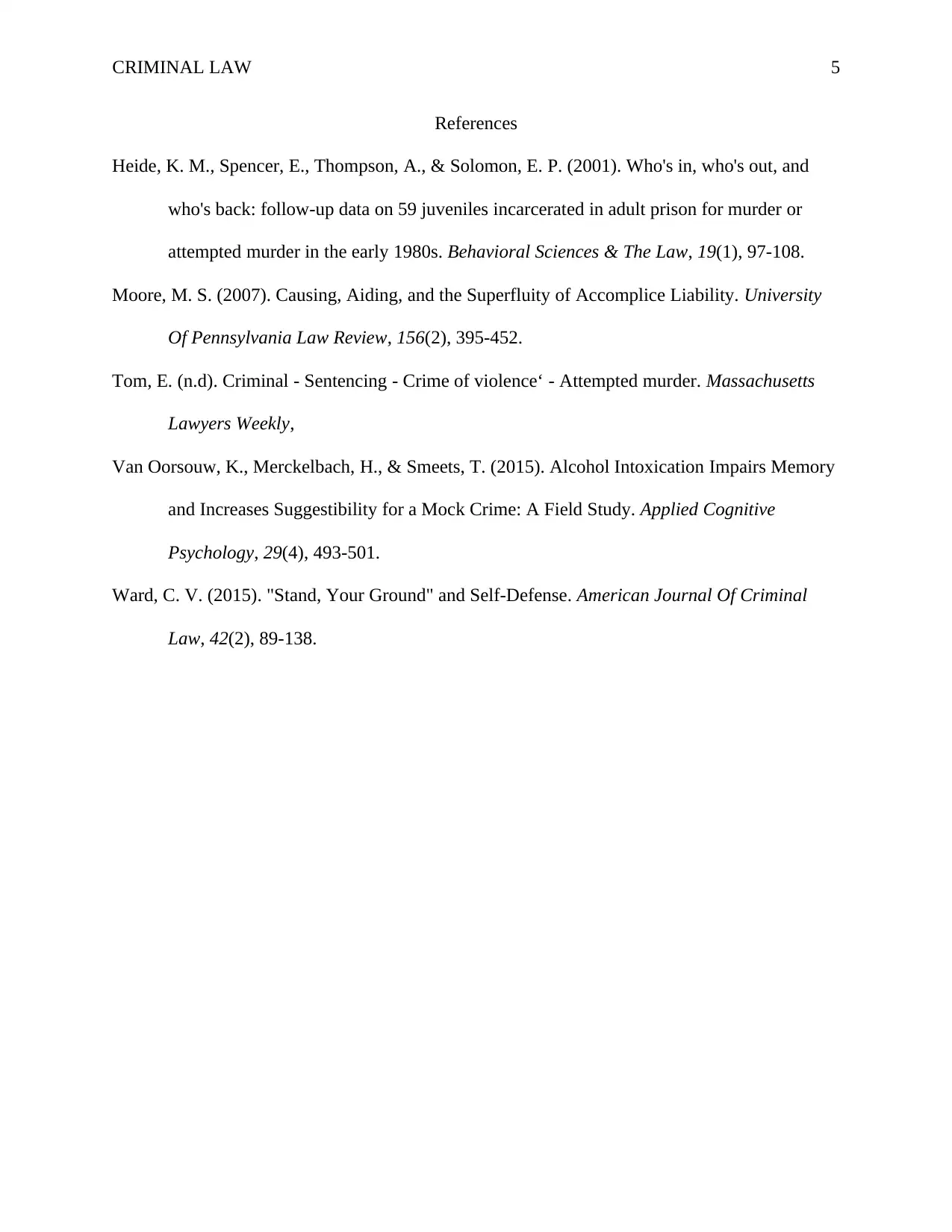
CRIMINAL LAW 5
References
Heide, K. M., Spencer, E., Thompson, A., & Solomon, E. P. (2001). Who's in, who's out, and
who's back: follow-up data on 59 juveniles incarcerated in adult prison for murder or
attempted murder in the early 1980s. Behavioral Sciences & The Law, 19(1), 97-108.
Moore, M. S. (2007). Causing, Aiding, and the Superfluity of Accomplice Liability. University
Of Pennsylvania Law Review, 156(2), 395-452.
Tom, E. (n.d). Criminal - Sentencing - Crime of violence‘ - Attempted murder. Massachusetts
Lawyers Weekly,
Van Oorsouw, K., Merckelbach, H., & Smeets, T. (2015). Alcohol Intoxication Impairs Memory
and Increases Suggestibility for a Mock Crime: A Field Study. Applied Cognitive
Psychology, 29(4), 493-501.
Ward, C. V. (2015). "Stand, Your Ground" and Self-Defense. American Journal Of Criminal
Law, 42(2), 89-138.
References
Heide, K. M., Spencer, E., Thompson, A., & Solomon, E. P. (2001). Who's in, who's out, and
who's back: follow-up data on 59 juveniles incarcerated in adult prison for murder or
attempted murder in the early 1980s. Behavioral Sciences & The Law, 19(1), 97-108.
Moore, M. S. (2007). Causing, Aiding, and the Superfluity of Accomplice Liability. University
Of Pennsylvania Law Review, 156(2), 395-452.
Tom, E. (n.d). Criminal - Sentencing - Crime of violence‘ - Attempted murder. Massachusetts
Lawyers Weekly,
Van Oorsouw, K., Merckelbach, H., & Smeets, T. (2015). Alcohol Intoxication Impairs Memory
and Increases Suggestibility for a Mock Crime: A Field Study. Applied Cognitive
Psychology, 29(4), 493-501.
Ward, C. V. (2015). "Stand, Your Ground" and Self-Defense. American Journal Of Criminal
Law, 42(2), 89-138.
1 out of 5
Your All-in-One AI-Powered Toolkit for Academic Success.
+13062052269
info@desklib.com
Available 24*7 on WhatsApp / Email
![[object Object]](/_next/static/media/star-bottom.7253800d.svg)
Unlock your academic potential
Copyright © 2020–2025 A2Z Services. All Rights Reserved. Developed and managed by ZUCOL.
